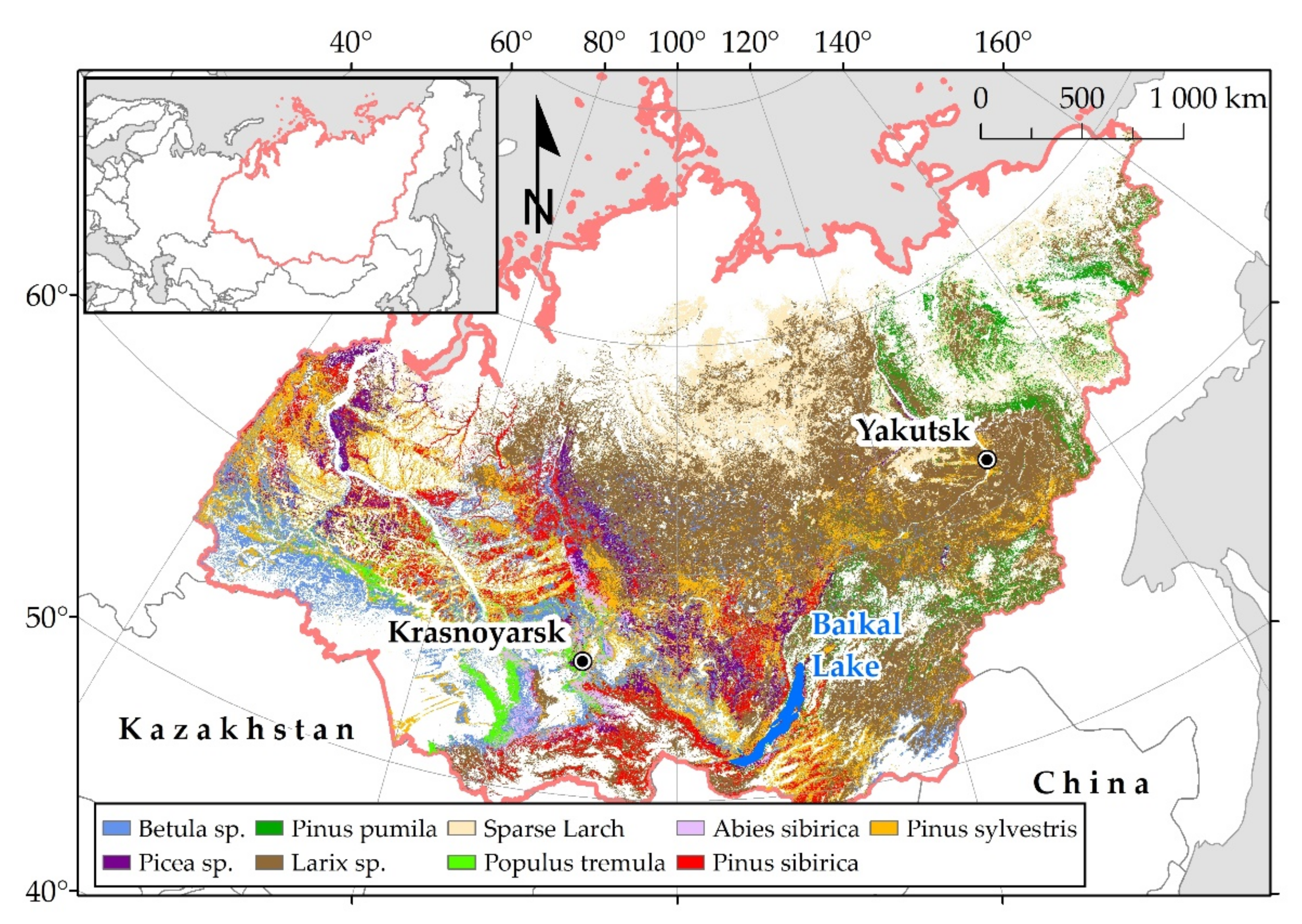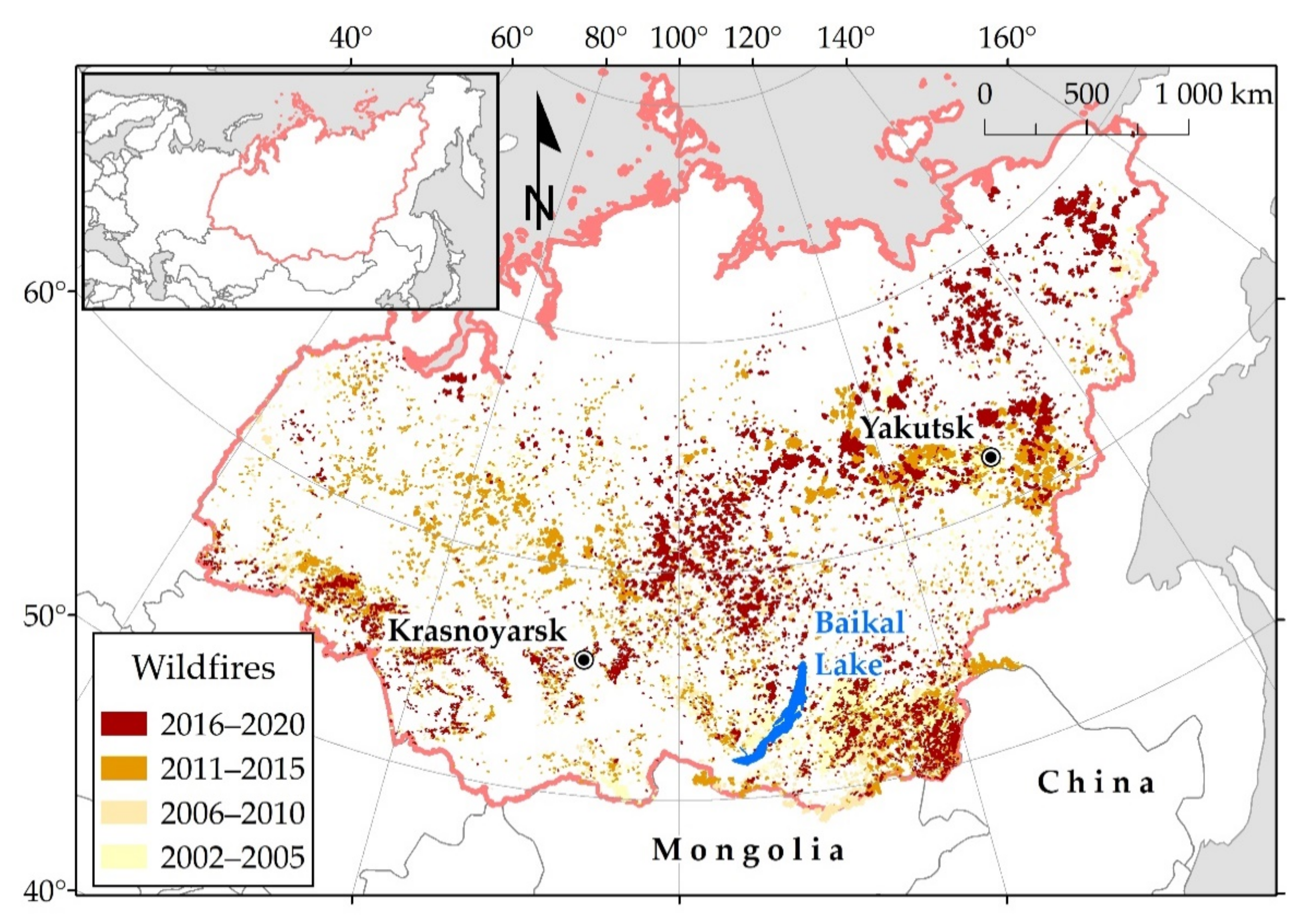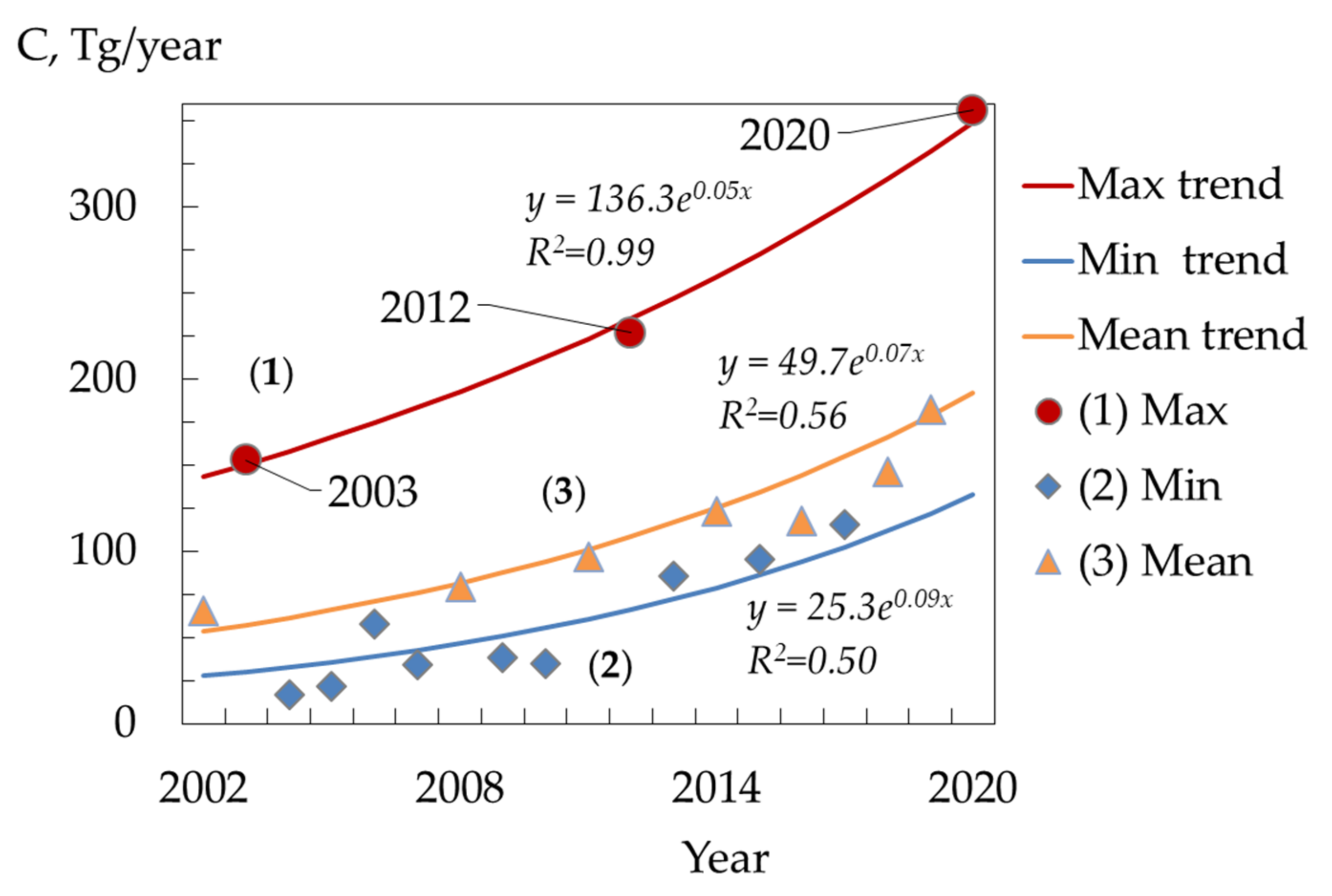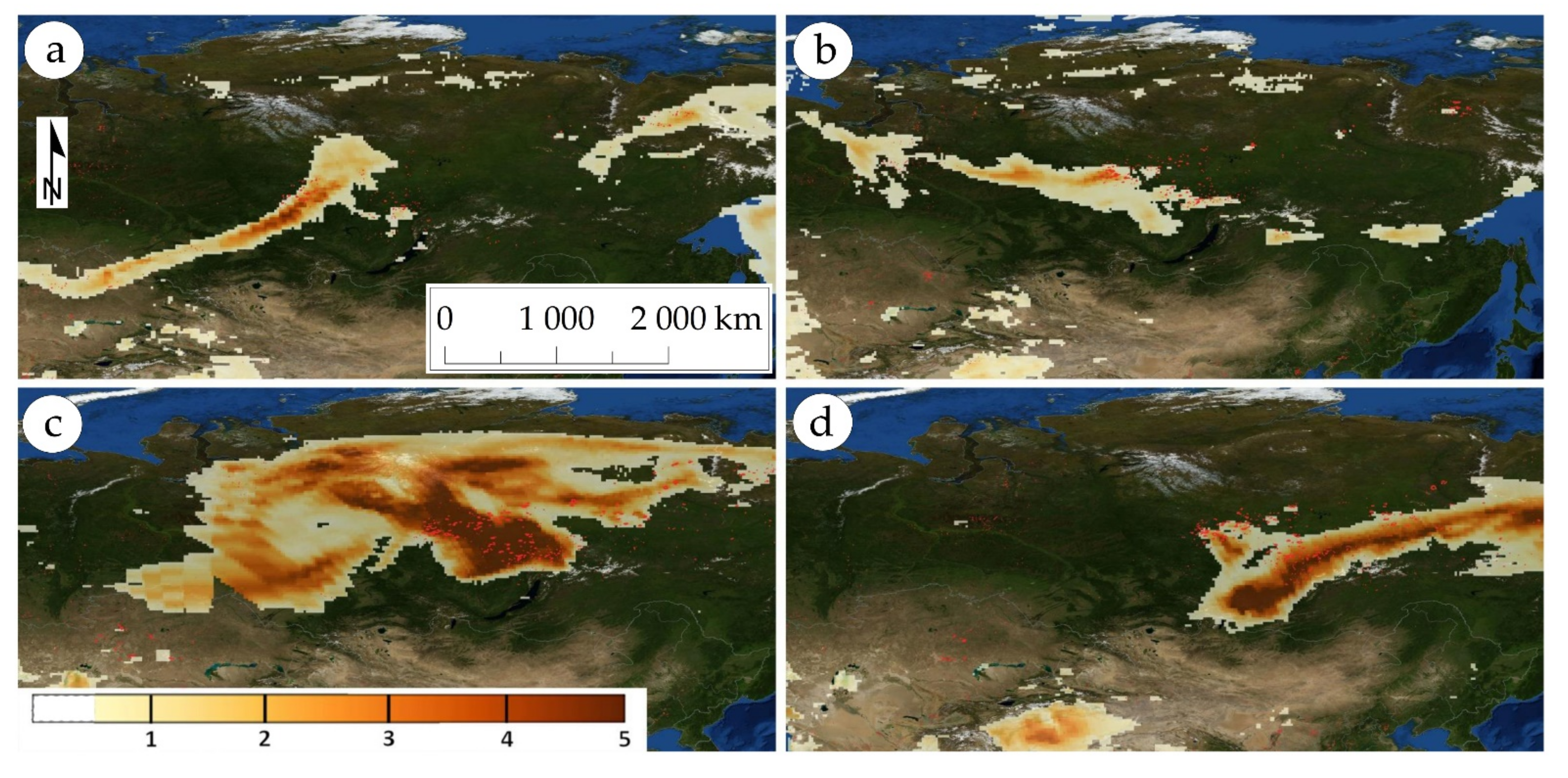Current Trend of Carbon Emissions from Wildfires in Siberia
Abstract
1. Introduction
2. Materials and Methods
2.1. Study Area
2.2. Data on Wildfires
2.3. Classification of Wildfire Polygons in Terms of FRP
2.4. Estimation of Fire Emissions of Carbon
3. Results
3.1. Fire Statistics
3.2. Ratio of Fire Intensity Areas
3.3. Direct Carbon Emissions
4. Discussion
4.1. Burning in Forests of Siberia
4.2. Carbon Emissions
4.3. Limitations
5. Conclusions
Author Contributions
Funding
Institutional Review Board Statement
Informed Consent Statement
Data Availability Statement
Acknowledgments
Conflicts of Interest
References
- Conard, S.G.; Sukhinin, A.I.; Stocks, B.J.; Cahoon, D.R.; Davidenko, E.P.; Ivanova, G.A. Determining effects of area burned and fire severity on carbon cycling and emissions in Siberia. Clim. Chang. 2002, 55, 197–211. [Google Scholar] [CrossRef]
- McRae, D.J.; Conard, S.G.; Ivanova, G.A.; Sukhinin, A.I.; Baker, S.; Samsonov, Y.N.; Blake, T.W.; Ivanov, V.A.; Ivanov, A.V.; Churkina, T.V.; et al. Variability of fire behavior, fire effects, and emissions in Scotch pine forests of Central Siberia. Mitig. Adapt. Strateg. Glob. Chang. 2006, 11, 45–74. [Google Scholar] [CrossRef]
- Shvidenko, A.Z.; Schepaschenko, D.G. Climate Change and Wildfires in Russia. Contemp. Probl. Ecol. 2013, 6, 50–61. [Google Scholar] [CrossRef]
- Kharuk, V.I.; Ponomarev, E.I.; Ivanova, G.I.; Dvinskaya, M.L.; Coogan, S.C.P.; Flannigan, M.D. Wildfires in the Siberian taiga. Ambio 2021. [Google Scholar] [CrossRef]
- Bondur, V.; Gordo, K.A.; Kladov, V.L. Spacetime Distributions of Wildfire Areas and Emissions of Carbon-Containing Gases and Aerosols in Northern Eurasia according to Satellite-Monitoring Data. Izv. Atmos. Ocean. Phys. 2017, 53, 859–874. [Google Scholar] [CrossRef]
- Ponomarev, E.I.; Shvetsov, E.G.; Kharuk, V.I. The Intensity of Wildfires in Fire Emissions Estimates. Russ. J. Ecol. 2018, 49, 492–499. [Google Scholar] [CrossRef]
- Panov, A.V.; Prokushkin, A.S.; Bryukhanov, A.V.; Korets, M.A.; Ponomarev, E.I.; Sidenko, N.V.; Zrazhevskaya, G.K.; Timokhina, A.V. A Complex Approach for the Estimation of Carbonaceous Emissions from Wildfires in Siberia. Russ. Meteorol. Hydrol. 2018, 43, 295–301. [Google Scholar] [CrossRef]
- NASA. Siberian Smoke Reaches, U.S. and Canada. 2019. Available online: https://www.nasa.gov/image-feature/goddard/2019/siberian-smoke-reaches-us-canada (accessed on 25 March 2021).
- Cottle, P.; Strawbridge, K.; McKendry, I. Long-range transport of Siberian wildfire smoke to British Columbia: Lidar observations and air quality impacts. Atmos. Environ. 2014, 90, 71–77. [Google Scholar] [CrossRef]
- Goldammer, J.G. (Ed.) Vegetation Fires and Global Change. Challenges for Concerted International Action. A White Paper directed to the United Nations and International Organizations; Kessel Publishing House: Remagen-Oberwinter, Germany, 2013; Available online: http://www.fire.unifreiburg.de/latestnews/Vegetation-Fires-GlobalChange-UN-White-Paper-GFMC-2013.pdf (accessed on 25 March 2021).
- Soja, A.J.; Cofer, W.R.; Shugart, H.H.; Sukhinin, A.I.; Stackhouse, P.W., Jr.; McRae, D.J.; Conard, S.G. Estimating fire emissions and disparities in boreal Siberia (1998–2002). J. Geophys. Res. 2004, 109, D14S06. [Google Scholar] [CrossRef]
- Ivanova, G.A.; Ivanov, V.A.; Kukavskaya, E.A.; Conard, S.G.; McRae, D.J. Effect of Fires on Carbon Emission in the Pine Forests of Middle Siberia. Sib. J. Ecol. 2007, 14, 885–895. (In Russian) [Google Scholar]
- Conard, S.G.; Ivanova, G.A. Wildfire in Russian Boreal Forests—Potential Impacts of Fire Regime Characteristics on Emissions and Global Carbon Balance Estimates. Environ. Pollut. 1997, 98, 305–313. [Google Scholar] [CrossRef]
- Kukavskaya, E.; Soja, A.; Petkov, A.; Ponomarev, E.; Ivanova, G.; Conard, S. Fire Emissions Estimates in Siberia: Evaluation of Uncertainties in Area Burned, Land Cover, and Fuel Consumption. Can. J. For. Res. 2013, 43, 493–506. [Google Scholar] [CrossRef]
- Bartalev, S.A.; Stytsenko, F.V.; Egorov, V.A.; Loupian, E.A. Satellite assessment of fire-caused forest mortality in Russia. Forestry (Lesovedenie) 2015, 2, 83–94. (In Russian) [Google Scholar]
- Wooster, M.J.; Roberts, G.; Perry, G.L.W.; Kaufman, Y.J. Retrieval of biomass combustion rates and totals from fire radiative power observations: FRP derivation and calibration relationships between biomass consumption and fire radiative energy release. J. Geophys. Res. 2005, 110, D24311. [Google Scholar] [CrossRef]
- Ichoku, C.; Kaufman, Y.J. A method to derive smoke emission rates from MODIS fire radiative energy measurements. IEEE Trans. Geosci. Remote Sens. 2005, 43, 2636–2649. [Google Scholar] [CrossRef]
- Vermote, E.; Ellicott, E.; Dubovik, O.; Lapyonok, T.; Chin, M.; Giglio, L.; Roberts, G.J. An approach to estimate global biomass burning emissions of organic and black carbon from MODIS fire radiative power. J. Geophys. Res. 2009, 114, 1–22. [Google Scholar] [CrossRef]
- Shvidenko, A.Z.; Shchepashchenko, D.G.; Vaganov, E.A.; Sukhinin, A.I.; Maksyutov, S.; McCallum, I.; Lakyda, I.P. Impact of wildfire in Russia between 1998–2010 on ecosystems and the global carbon budget. Dokl. Earth Sci. 2011, 441, 1678–1682. [Google Scholar] [CrossRef]
- Zamolodchikov, D.G.; Grabovskii, V.I.; Kraev, G.N. Dynamics of Carbon Budget in Forests of Russia for Last Twenty Years. Forestry 2011, 6, 16–28. (In Russian) [Google Scholar]
- Balashov, I.; Bartalev, S.; Burtsev, M.; Vorushilov, I.; Egorov, V.; Kashnitskii, A.; Khovratovich, T.; Khvostikov, S.A.; Kobets, D.; Loupian, E.; et al. Vega-Les Information System. Actual Features and Future Evolution. IOP Conf. Ser. Earth Environ. Sci. 2020, 507, 012002. [Google Scholar] [CrossRef]
- Ponomarev, E.I.; Shvetsov, E.G. Satellite detection of forest fires and geoinformation methods for calibrating of the result. Issled. Zemli Kosm. (Remote Sens.) 2015, 1, 84–91. (In Russian) [Google Scholar] [CrossRef]
- Giglio, L.; Descloitres, J.; Justice, C.; Kaufman, Y. An enhanced contextual fire detection algorithm for MODIS. Remote Sens. Environ. 2003, 87, 273–282. [Google Scholar] [CrossRef]
- Ponomarev, E.I.; Shvetsov, E.G.; Litvintsev, K.Y. Calibration of Estimates on Direct Wildfire Emissions from Remote Sensing Data. Izv. Atmos. Ocean. Phys. 2019, 55, 1065–1072. [Google Scholar] [CrossRef]
- Seiler, W.; Crutzen, P.J. Estimates of gross and net fluxes of carbon between the biosphere and atmosphere from biomass burning. Clim. Change 1980, 2, 207–247. [Google Scholar] [CrossRef]
- Ivanova, G.A.; Kukavskaya, E.A.; Ivanov, V.A.; Conard, S.G.; McRae, D.J. Fuel characteristics, loads and consumption in Scots pine forests of central Siberia. J. For. Res. 2020, 31, 2507–2524. [Google Scholar] [CrossRef]
- Tsvetkov, P.A. Adaptation of Larix gmelinii to Fires in the Northern Taiga of Central Siberia. Sib. J. Ecol. 2005, 1, 117–129. (In Russian) [Google Scholar]
- De Groot, W.J.; Cantin, A.S.; Flannigan, M.D.; Soja, A.J.; Gowman, L.M.; Newbery, A. A comparison of Canadian and Russian boreal forest fire regimes. For. Ecol. Manag. 2013, 294, 23–34. [Google Scholar] [CrossRef]
- Shvetsov, E.G.; Ponomarev, E.I. Postfire Effects in Siberian Larch Stands on Multispectral Satellite Data. Contemp. Probl. Ecol. 2020, 13, 104–112. [Google Scholar] [CrossRef]
- IPCC. Climate Change 2014: Impacts, Adaptation, and Vulnerability; Summaries, Frequently Asked Questions, and Cross-Chapter Boxes, Report of the Intergovernmental Panel on Climate Change; Field, C.B., Barros, V., Dokken, D.J., Mach, M.D., Mastrandrea, T.E., Bilir, M., Eds.; World Meteorological Organization: Geneva, Switzerland, 2014. [Google Scholar]
- Valendik, E.N.; Kisilyakhov, E.K.; Ryzhkova, V.A.; Ponomarev, E.I.; Danilova, I.V. Conflagration fires in taiga landscapes of Central Siberia. Geogr. Nat. Resour. 2014, 35, 41–47. [Google Scholar] [CrossRef]
- Hayasaka, H.; Yamazaki, K.; Naito, D. Weather conditions and warm air masses during active fire-periods in boreal forests. Polar Sci. 2019, 22, 100472. [Google Scholar] [CrossRef]
- Conard, S.G.; Ponomarev, E.I. Fire in the North—The 2020 Siberian Fire Season. Wildfire 2020, 29, 26–32. [Google Scholar]
- Witze, A. The Arctic is burning like never before—And that’s bad news for climate change. Nature 2020, 585, 336–337. [Google Scholar] [CrossRef] [PubMed]
- Amiro, B.; Cantin, A.; Flannigan, M.; De Groot, W. Future Emissions from Canadian boreal forest fires. Can. J. For. Res. 2009, 39, 383–395. [Google Scholar] [CrossRef]
- Ponomarev, E.I.; Shvetsov, E.G.; Usataya, Y.O. Determination of the Energy Properties of Wildfires in Siberia by Remote Sensing. Izv. Atmos. Ocean. Phys. 2018, 54, 979–985. [Google Scholar] [CrossRef]
- Ponomarev, E.I.; Kharuk, V.I. Wildfire Occurrence in Forests of the Altai–Sayan Region under Current Climate Changes. Contemp. Probl. Ecol. 2016, 9, 29–36. [Google Scholar] [CrossRef]
- Ponomarev, E.I.; Skorobogatova, A.S.; Ponomareva, T.V. Wildfire Occurrence in Siberia and Seasonal Variations in Heat and Moisture Supply. Russ. Meteorol. Hydrol. 2018, 43, 456–463. [Google Scholar] [CrossRef]
- McCarty, J.L.; Smith, T.E.L.; Turetsky, M.R. Arctic fires re-emerging. Nat. Geosci. 2020, 13, 658–660. [Google Scholar] [CrossRef]
- Ciavarella, A.; Cotterill, D.; Stott, P.; Kew, S.; Sjoukje, P.; Van Oldenborgh, G.J.; Skålevåg, A.; Lorenz, P.; Robin, Y.; Otto, F.; et al. Prolonged Siberian Heat of 2020. World Weather Attribution Organization. 2020. Available online: https://www.worldweatherattribution.org/siberian-heatwave-of-2020-almost-impossible-without-climate-change (accessed on 25 March 2021).
- Wiedinmyer, C.; Neff, J.C. Estimates of CO2 from fires in the United States: Implications for carbon management. Carbon Balance Manag. 2007, 2. [Google Scholar] [CrossRef]
- Veraverbeke, S.; Rogers, B.M.; Randerson, J.T. Daily burned area and carbon emissions from boreal fires in Alaska. Biogeosciences 2015, 12, 3579–3601. [Google Scholar] [CrossRef]
- Amiro, B.D.; Todd, J.B.; Wotton, B.M.; Logan, K.A.; Flannigan, M.D.; Stocks, B.J.; Mason, J.A.; Martell, D.L.; Hirsch, K.G. Direct carbon emissions from Canadian forest fires, 1959 to 1999. Can. J. For. Res. 2001, 31, 512–525. [Google Scholar] [CrossRef]
- Chen, G.; Hayes, D.J.; David McGuire, A. Contributions of wildland fire to terrestrial ecosystem carbon dynamics in North America from 1990 to 2012. Glob. Biogeochem. Cycles 2017, 31, 878–900. [Google Scholar] [CrossRef]
- Torres, O.; Bhartia, P.K.; Herman, J.R.; Ahmad, Z.; Gleason, J. Derivation of aerosol properties from satellite measurements of backscattered ultraviolet radiation: Theoretical basis. J. Geophys. Res. 1998, 103, 17099–17110. [Google Scholar] [CrossRef]
- Ponomarev, E.I.; Kharuk, V.I.; Ranson, J.K. Wildfires Dynamics in Siberian Larch Forests. Forests 2016, 7, 125. [Google Scholar] [CrossRef]
- Tchebakova, N.M.; Parfenova, E.I.; Soja, A.J. Significant Siberian Vegetation Change is Inevitably Brought on by the Changing Climate. In Novel Methods for Monitoring and Managing Land and Water Resources in Siberia; Mueller, L., Sheudshen, A., Eulenstein, F., Eds.; Springer Water, Springer: Cham, Switzerland, 2016; pp. 269–285. [Google Scholar] [CrossRef]
- Kukavskaya, E.A.; Buryak, L.V.; Shvetsov, E.G.; Conard, S.G.; Kalenskaya, O.P. The impact of increasing fire frequency on forest transformations in southern Siberia. For. Ecol. Manag. 2016, 382, 225–235. [Google Scholar] [CrossRef]
- Mathews, B.J.; Strand, E.K.; Smith, A.M.; Hudak, A.T.; Dickinson, B.; Kremens, R.L. Laboratory experiments to estimate interception of infrared radiation by tree canopies. Int. J. Wildland Fire 2016, 25, 1009–1014. [Google Scholar] [CrossRef]






| Intervals | Number of Wildfires, ×1000 | Burned Area, MHa |
|---|---|---|
| 2001–2005 | 11.18 ± 5.07 | 6.32 ± 3.83 |
| 2006–2010 | 19.72 ± 3.56 | 7.56 ± 2.12 |
| 2011–2015 | 17.30 ± 4.30 | 15.40 ± 4.09 |
| 2016–2020 | 13.72 ± 2.44 | 16.06 ± 6.84 |
| 20-year average | 15.48 ± 2.33 | 11.34 ± 2.88 |
| Dominant Tree Stand | Area of Tree Stands, 106 ha | Number of Wildfires, % of Total | RFF, per 106 ha Per Year | Burned Area, % of Total | RBA, % of Burned Annually |
|---|---|---|---|---|---|
| Larch (Larix sibirica, L. dahurica, L. , cajanderi) | ~300 | 43.1 | 8.7 | 60.0 | 1.10 |
| Scots pine (Pinus sylvestris) | 95 | 26.0 | 16.7 | 16.9 | 0.97 |
| Deciduous (Populus tremula and Betula spp.) | 77 | 20.6 | 16.4 | 13.2 | 0.99 |
| Dark coniferous stands (Pinus sibirica, Abies sibirica, Picea obovata) | 75 | 7.0 | 5.6 | 6.4 | 0.49 |
| Interface between taiga and tundra (Pinus pumila) | 25 | 0.5 | 1.2 | 3.2 | 0.73 |
| Other types/Tundra | ~180 | 2.8 | 1.0 | 0.3 | 0.01 |
| Latitude Range, N | % of Total Burned Area | Dominant Vegetation | ||
|---|---|---|---|---|
| Low | Medium | High | ||
| 70+ | 39.3 | 47.1 | 13.6 | Tundra and bog vegetation |
| 65–70 | 33.5 | 47.8 | 18.7 | Sparse larch, Pinus pumila |
| 60–65 | 41.8 | 45.0 | 13.2 | Larch, Scots pine, mixed forests |
| 55–60 | 45.6 | 43.5 | 10.9 | Scots pine, deciduous, dark coniferous |
| 50–55 | 38.5 | 47.7 | 13.8 | Steppe vegetation, mountain forests, dark coniferous |
| Dominant Vegetation | Tg C/year | Mg C/ha | % of Annual Emission |
|---|---|---|---|
| (Min–Max) | |||
| Larch | 43.0–52.0 | 15.5–18.8 | 51.6–62.4 |
| Pine | 11.0–12.0 | 16.7–18.0 | 13.2–14.2 |
| Deciduous/mixed | 3.8–5.0 | 13.7–17.5 | 4.5–5.7 |
| Dark coniferous | 1.9–3.1 | 12.7–20.4 | 2.3–3.7 |
| Tundra and bog vegetation (of 70 + N) | 0.2–1.0 * | NA | 0.2–0.8 |
Publisher’s Note: MDPI stays neutral with regard to jurisdictional claims in published maps and institutional affiliations. |
© 2021 by the authors. Licensee MDPI, Basel, Switzerland. This article is an open access article distributed under the terms and conditions of the Creative Commons Attribution (CC BY) license (https://creativecommons.org/licenses/by/4.0/).
Share and Cite
Ponomarev, E.; Yakimov, N.; Ponomareva, T.; Yakubailik, O.; Conard, S.G. Current Trend of Carbon Emissions from Wildfires in Siberia. Atmosphere 2021, 12, 559. https://doi.org/10.3390/atmos12050559
Ponomarev E, Yakimov N, Ponomareva T, Yakubailik O, Conard SG. Current Trend of Carbon Emissions from Wildfires in Siberia. Atmosphere. 2021; 12(5):559. https://doi.org/10.3390/atmos12050559
Chicago/Turabian StylePonomarev, Evgenii, Nikita Yakimov, Tatiana Ponomareva, Oleg Yakubailik, and Susan G. Conard. 2021. "Current Trend of Carbon Emissions from Wildfires in Siberia" Atmosphere 12, no. 5: 559. https://doi.org/10.3390/atmos12050559
APA StylePonomarev, E., Yakimov, N., Ponomareva, T., Yakubailik, O., & Conard, S. G. (2021). Current Trend of Carbon Emissions from Wildfires in Siberia. Atmosphere, 12(5), 559. https://doi.org/10.3390/atmos12050559







